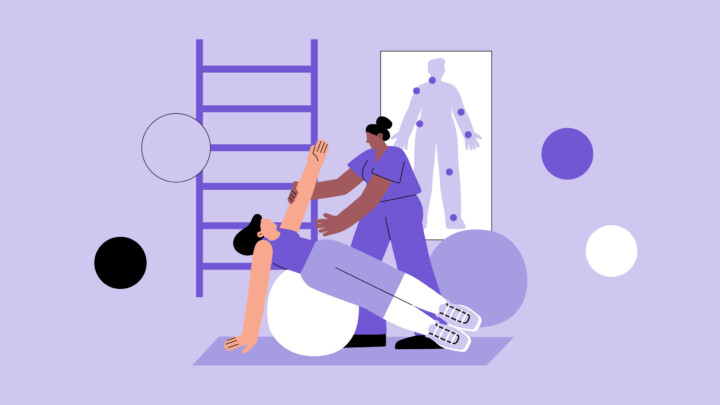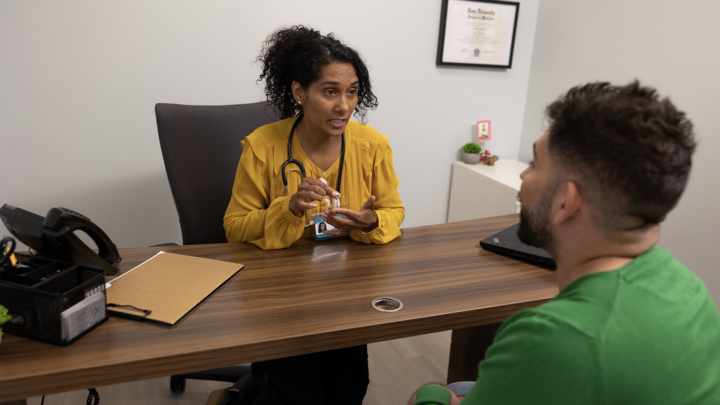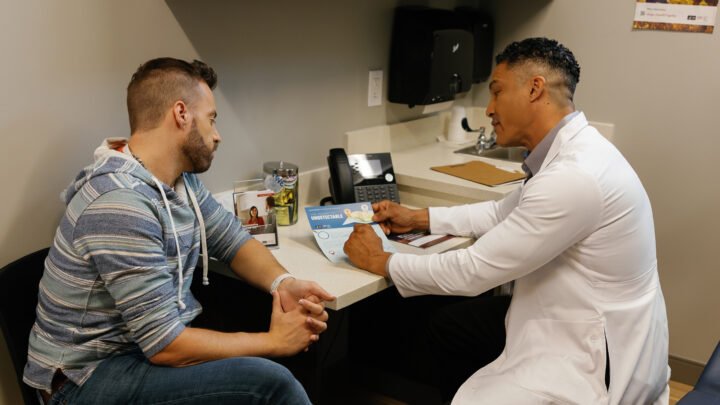
The World Health Organization estimates that on average, only around 50% of patients with chronic conditions adhere to their prescribed treatment plans in developed countries. This number is even lower in developing regions, and 53% of Sermo members say that both non-compliance and nonadherence are already big concerns in their practice. Patients who refuse to adhere to a treatment plan, for whatever reason, have poor outcomes, and doctors can become extremely frustrated.
Most—if not all—physicians will have to deal with patient non-compliance at some point in their careers. Developing strategies to minimize its impact helps improve patient outcomes and reduce physician stress and burnout, while maintaining high standards of care.
What is patient non-compliance?
Patient non-compliance is an intentional refusal to follow a course of treatment and/or take prescribed medication. While most non-compliant patients are not confrontational, some may express frustration or resistance during medical discussions. In rare instances, this tension can escalate into challenging interactions for clinicians.
As one physician on Sermo noted: “Non-compliance/non-adherence is a major issue in most areas of medicine. Sometimes it can even be difficult to fully recognize. The reasons for this are highly variable from patient to patient. The response to this will also vary from patient to patient. Time should always be spent to gauge treatment compliance/adherence.”
What is the difference between being non-compliant and non-adherent?
The terms non-compliant and non-adherent are sometimes used interchangeably, but they actually mean two different things. A non-compliant patient is one who intentionally refuses to follow a treatment plan. A non-adherent patient is one who is not intentionally non-compliant but rather struggles with a secondary cause that keeps them from following a treatment plan. This can be due to confusion, feeling overwhelmed, a language barrier, mistrust, or cultural differences. The difference between the two definitions lies in patient awareness and intention.
According to a family doctor on Sermo, “Sometimes it’s hard to differentiate between nonadherence and noncompliance, but there are definitely different things that can help combating both. Depending on the reason, changing to a lower cost med, educating the patient on the importance of therapy and simplifying regimens where possible can all be helpful.ˮ

How non-compliant patients affect physicians
“As an anesthesiologist, I routinely see the effects of patient noncompliance and the problems it can cause. I often have to delay surgery and occasionally go as far as admit [patients] for pre operative blood pressure and glycemic control,ˮ shares a physician on Sermo.
In addition to disrupting treatment plans, non-compliant patients can adversely affect physicians in several meaningful ways:
- Physician wellbeing: caring for patients who refuse care without clear reasons can erode professional satisfaction and add to the emotional toll on physicians. Physician burnout has been linked to increased error rates, lower professionalism, and reduced patient satisfaction.
- Professional growth: persistent non-adherence among patients may reflect negatively on performance evaluations, even when non-compliance is outside the physician’s control.
- Compassion fatigue: A reduced ability to feel sympathy or empathy for the suffering of others, known as compassion fatigue, can be worsened by non-compliant patients. Doctors may find it difficult to maintain compassion for patients who ignore medical advice and later suffer the consequences.
- Ethical balance: In the case of non-compliance, physicians may find it difficult to balance medical responsibility and patient autonomy.
- Compensation: For 23% of physicians on Sermo, reimbursement and/or performance bonuses can be impacted by patient adherence rates.
8 possible reasons for patient non-compliance
Understanding why patients are non-compliant is the first step towards creating an effective treatment strategy. According to one internist on Sermo, “Multiple factors explain this observation, including cost, mistrust of the system/pharma, the Google effect (“I’ve done research…”) and personal experts “I’ve heard from friends…”.”
Physicians surveyed on Sermo voted cost as the most common reason, receiving 30% of the vote, among other factors such as literacy, fear, overwhelm and mistrust:
Financial constraints
In some cases, patients don’t comply because they simply can’t afford the treatment or medication. Patients with financial constraints may ration their medication or take a lower dose than prescribed. In today’s world, it is imperative that physicians consider cost when creating a treatment plan, as 64% of physicians on Sermo are already seeing patients refuse treatment due to this factor.
Patients struggling with costs may need help finding financial assistance, which many drug manufacturers offer. Another consideration may be that the patient cannot afford to take the amount of time off work needed for treatment, or that they risk losing their job in areas with poor employment protection.
Fear of the treatment or physicians
Medical anxiety or fear can easily lead to non-compliance. Patients with fear of medical procedures—including injections, blood draws, or equipment—often exhibit avoidance behaviors that interfere with screening, medication use, or follow-up visits. Additionally, a fear or distrust of taking drugs, known as pharmacophobia, can undermine the patient’s willingness to adhere to prescriptions.
Good information can reduce fear: “…you have to try to explain to the patient why they need the treatment, the function it will perform in their body and give various options so that they can comply with the treatment,ˮ shares a GP.
Low health literacy/lack of understanding of treatment
Some patients may not understand what a treatment is going to do for them or why it’s important to complete a course of treatment to its end, such as in the case of the development of drug-resistant TB. This can be a particular problem when treating an asymptomatic condition. For example, hypertension—often called the “silent killer”—typically has no symptoms in its early stages. Many patients stop taking their medication because they don’t feel any different, unaware that untreated high blood pressure can silently cause irreversible damage to the heart, kidneys, eyes, or brain. Left uncontrolled, it can lead to heart attack or a stroke—two of the most common causes of death worldwide.
These patients need clear information, and the importance of adherence explained to them in layman’s terms – without compromising on bedside manner. Per an OB-GYN on Sermo: “Signs vs. Symptoms. Without perceptible symptoms many patients will re-assert their own power and relate that they “took myself off the medication.” Continued follow-up is crucial for successful long term therapy.ˮ

Feeling overwhelmed
Patients with complex or multiple conditions can end up overwhelmed by both their disease(s) and their treatment. These individuals may suffer from treatment burden as they struggle to balance healthcare administration, scheduling of in-person visits, and financial strain.
Seniors with even mild cognitive impairment are particularly vulnerable, as are children, who may also rely on caretakers or family members to ensure they take the correct medications at the appropriate intervals.
According to a General Practitioner on Sermo: “Many individuals take large amounts of medicine and this can lead to confusion or reluctance to take medicines. Aids such as prescription pill boxes are helpful for some individuals, but may still pose a challenge especially in cognitive impairment.ˮ
Mistrust of the healthcare system
Skepticism toward science—especially around vaccines—can contribute to broader mistrust in the healthcare system. Some patients may believe medications are pushed due to pharmaceutical industry influence, or place their trust in non-medical voices promoting lifestyle changes as complete alternatives to treatment.
A recent example is the death of TV personality Ananda Lewis, who refused a medically recommended mastectomy after a breast cancer diagnosis, instead opting for holistic treatments. Her story highlights how distrust in conventional medicine can lead to tragic outcomes and decisions that patients may later come to regret.
Untreated mental illness
This article has already mentioned anxieties and phobias around healthcare itself, but any kind of unrecognized or untreated mental illness can contribute to non-compliance. Patients facing depression are up to 3 times more likely to be non-compliant. These patients might need a referral for treatment, but this can get complex as they may not comply with mental illness treatment either.
Concerns about long-term medication side effects
Concern about potential side effects can lead some patients to avoid taking prescribed medication, even if they haven’t experienced those effects themselves. It’s important for physicians to openly discuss these fears, helping patients feel heard and supported. Reassurance about monitoring, alternative treatment options, or symptom management strategies can improve trust and encourage adherence.
How do cultural and belief systems influence patient adherence?
Physicians often face challenges balancing respect for patients’ cultural and personal beliefs with the need to follow evidence-based medical practices. For instance, recognizing that African-American patients—particularly elders—may harbor mistrust toward the healthcare system can help physicians anticipate and address potential barriers to care. Language differences between patients and doctors can further complicate communication; while interpreters may assist, their use can raise concerns about patient privacy.
Additionally, patients may rely on traditional therapies such as prayer, home remedies, or folk medicine before seeking conventional care. They might not disclose use of nontraditional treatments, including herbal supplements, which can lead to harmful interactions. These factors contribute to healthcare inequities by creating additional obstacles to accessing care and causing patients to hesitate in seeking treatment due to fears their beliefs will be dismissed.
An internist in Nigeria sums up the problem this way: “The believe system in our environment of practice is another major reason for noncompliance and adherence. So many people still harbors cultural and religious beliefs to be solutions to their medical problems despite them seeking medical care from a physician. There is a need to strike a balance between their beliefs and the health management plan given to them.ˮ
Strategies to help physicians deal with non-compliant patients
Doctors may find themselves needing to “treat” non-compliance along with the disease or condition the patient is facing. Many doctors rely on opinion leaders to help them develop strategies, as well as their own lived experiences, but the consensus is clear: 89% of doctors on Sermo feel more can be done to improve patient compliance.
A recent poll on Sermo revealed these top strategies:
Build Trust and Rapport
43% of surveyed physicians voted that increased time with the patient to discuss their condition and their proposed treatment plan was the #1 strategy to avoiding non-compliance. Doctors should take time to build trust with their patients, especially if there is a cultural barrier. This also increases patient satisfaction.
One internist says “While patient noncompliance can be frustrating for healthcare providers, it’s important to approach the issue with empathy rather than judgment. Patients may be struggling with complex life circumstances, such as stress or lack of access to resources, that make adherence difficult. By fostering a collaborative relationship and tailoring care plans to individual needs, providers can help patients overcome barriers to compliance.ˮ
Simplify treatment plans
Voted by 31% of physicians, streamlining treatment plans can significantly improve patient adherence. Whenever possible, avoid complex medication regimens unless clinically necessary. Simplified plans are not only easier for patients to follow—they may also reduce costs, making treatment more accessible and sustainable over time.
Tailor communication
A physician’s communication style may need to be adjusted to patient preferences. Using telehealth when possible can help improve communication for patients who prefer it, or who struggle to attend in-person visits.
A nephrologist on Sermo shared, “It is very common for patients not to attend consultations or for the therapeutic scheme to be altered in some way, so doctors must insist on the consequences of these practices, where the patient will always be the one to suffer.”
Follow up consistently
Arrange consistent follow ups with patients, including following up by direct means such as phone or email, or via an online patient portal. Keeping in touch can ensure patients know they can ask their doctor about any problems or side effects right away. Physicians can also use a collaborative care model to make sure follow-ups happen across the care team.
Documenting the treatment plan and any additional notes is also important in ensuring that both the patient and the care team have a written record of what was discussed and the instructions to follow.
Pill counting or measuring drug usage
For patients who struggle with taking their medication, doctors may need to engage in pill counting to ensure that they don’t miss a dose. A dedicated caregiver can help here, as well as pill boxes that make it clear when medication is taken, such as “day of the week” boxes or pill lids that report the time the container was last opened.
Involving the patient’s family
Family members often know how to communicate with patients more effectively than their physician does. Involving them can help reinforce treatment plans, support adherence, and bridge gaps in understanding—especially for pediatric, geriatric, or cognitively impaired patients. Additionally, caregivers can assist with medication management, appointment follow-ups, and emotional support, all of which contribute to better health outcomes and reduce the risk of non-compliance.
Know when to refer
Sometimes a patient may need help from a different specialist, such as a psychiatrist. Recognizing untreated mental illness or healthcare-related anxiety that might require further intervention is an important part of holistic care.
In other cases, a physician may determine that a patient would be better served by a different provider entirely—for example, one who shares the patient’s cultural background, language, or communication style. In these situations, it’s essential for the physician to set aside personal feelings or ego and prioritize what’s best for the patient’s health, comfort, and trust. A thoughtful referral can strengthen continuity of care and improve long-term outcomes.
Can a doctor refuse to treat a non-compliant patient?
In short—Yes. If a non-compliant patient is genuinely refusing to compromise on treatment and a doctor finds themselves unable to provide proper care, they can refuse to treat. It is important for physicians to document their interactions, so that they have a record of non-compliance on file for that patient.
According to one internist on Sermo, “I have had only one situation where a patient deliberately refused to follow the medication and treatment plan I presented to him (noncompliance). I was unable to convince him otherwise, so I had to unfortunately discharge him from my practice. In close to being in practice for four decades, this patient was the only one that I had to take this action.ˮ
Another US-based physician shared, “When I have a patient who is non compliant I try to discuss what the barriers are to the patient following instructions. Most often we can work this out and develop a plan that the patient can adhere to.”
The takeaway
Non-compliant patients are a concern for all physicians, one which can lead to frustration, stress, and even burnout. However, there is often an underlying reason for non-compliance, such as financial hardship, cultural beliefs, or mistrust. By approaching these situations with empathy, respect, and open communication, physicians can build stronger patient relationships and improve adherence over time.















